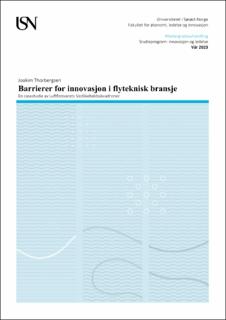| dc.contributor.advisor | Bentsen, Kristin | |
| dc.contributor.author | Thorbergsen, Joakim Jacob | |
| dc.date.accessioned | 2023-07-06T16:42:00Z | |
| dc.date.available | 2023-07-06T16:42:00Z | |
| dc.date.issued | 2023 | |
| dc.identifier | no.usn:wiseflow:6825538:55028755 | |
| dc.identifier.uri | https://hdl.handle.net/11250/3076867 | |
| dc.description.abstract | Luftfartssektoren anerkjennes for å være en av de største bidragsyterne til innovativ utvikling i global sammenheng, både innen teknologi, økonomi og samfunnsutvikling. Det samme kan sies om den militære luftfarten som på sin side står i bresjen for banebrytende teknologi. Vedlikeholdskonseptene og organisasjonene som skal opprettholde levetiden til dagens flymaskiner har dog lite å vise til av nyskaping sammenlignet med sektoren generelt. Denne masteroppgaven er en kvalitativ casestudie av Luftforsvaret der formålet har vært å identifisere hvilke faktorer som hindrer innovasjon i deres vedlikeholdsorganisasjon. Videre har formålet vært å forklare hvordan disse faktorene oppstår, og trekke paralleller til den flytekniske bransjen generelt. Studiens problemstilling er:
«Hvilke barrierer for innovasjon eksisterer i Luftforsvarets flytekniske bransje, og hva er årsaken til disse?».
For å besvare problemstillingen er det tatt utgangspunkt i en casestudie som tar for seg to avdelinger i Luftforsvaret. Det er benyttet semistrukturerte dybdeintervju og etnografiske observasjonsstudier over to uker for å innhente data. Informantene har alle lang erfaring, førstehåndskunnskap om flyvedlikehold, og kompetanse innen flere flytyper. Studien til Cinar et al. (2019); A systematic review of barriers to public sector innovations, er benyttet som et teoretisk rammeverk for å klassifisere ulike barrierer for innovasjon. Rammeverket bidrar til en bedre forståelse for hva det er som kjennetegner innovative barrierer, samt hva som er særegent med innovasjon i offentlig sektor.
Studiens funn viser til flere faktorer som hindrer innovasjon, og et interessant funn er det høye antallet barrierer som er identifisert. Barrieren som klassifiseres som «organisatoriske barrierer» viser seg å være den mest fremtredende kategorien i antall funn, mens «kontekstuelle barrierer» er identifisert som den største barrieren. Studien peker videre på at ulike barrierer henger sammen, og at de interagerer og påvirker hverandre gjensidig. Det argumenteres på bakgrunn av dette for en mer kompleks inndeling av barrierer i bransjen. Til slutt bygger oppgaven videre på det teoretiske rammeverket til Cinar et al. (2019), og det konstrueres teori som i større grad tar høyde for bransjens kontekstuelle rammer. | |
| dc.description.abstract | The aviation industry is recognized for being one of the main contributors to innovative development, whether its technology, economy, or our society in general. The same could be argued for military aviation, which is considered a spearhead for developing ground-breaking technology. The concepts and the organisations that maintain these highly technological aircraft, does somehow fall behind the rest of the industry when it comes to innovation. This master thesis is a qualitative case study of the Royal Norwegian Air Force where the goal has been to identify barriers for innovation within their maintenance organisation. Furthermore, an additional goal has been to explain how these barriers originate and draw parallels to the aviation maintenance industry in general. The study`s research question is:
“Which barriers to innovation exist in the Royal Norwegian Air Force maintenance organisation, and how do they originate?”
To answer the research question, the study is based upon a case study of two maintenance organisations within the Royal Norwegian Air Force. Collection of data is done through semi-structured interviews and ethnographic observations over a two-week period. The informants all have substantial experience, first-hand knowledge, and skills which extends over several types of aircraft. The article; A systematic review of barriers to public sector innovations, by Cinar et al. (2019) is used as a theoretical framework to classify different types of barriers to innovation. The framework also contributes to a better understanding of innovative barriers, and the distinctive characteristics of public sector innovations.
The study`s findings reveal several barriers to innovation, and an interesting finding is the number of barriers identified. The barrier classified as “organisational barriers” seems to be the most prominent regarding number of findings, while “contextual barriers” proves to be the most influential. Furthermore, the study shows how different barriers merge and influent each other in a mutual way. Thus, the study argues for a more dynamic categorisation of barriers. Finally, the thesis expands on the existing framework written by Cinar et al. (2019) to better account for the contextual peculiarities in the aviation maintenance industry. | |
| dc.language | nob | |
| dc.publisher | University of South-Eastern Norway | |
| dc.title | Barrierer for innovasjon i flyteknisk bransje | |
| dc.type | Master thesis | |
